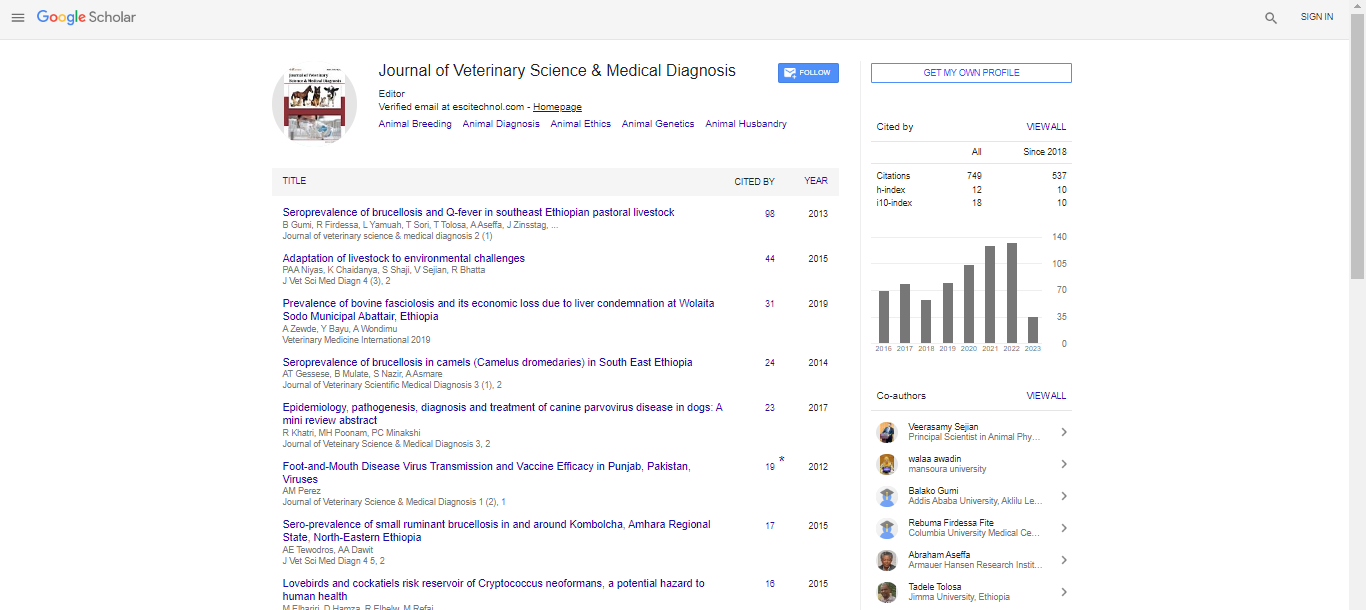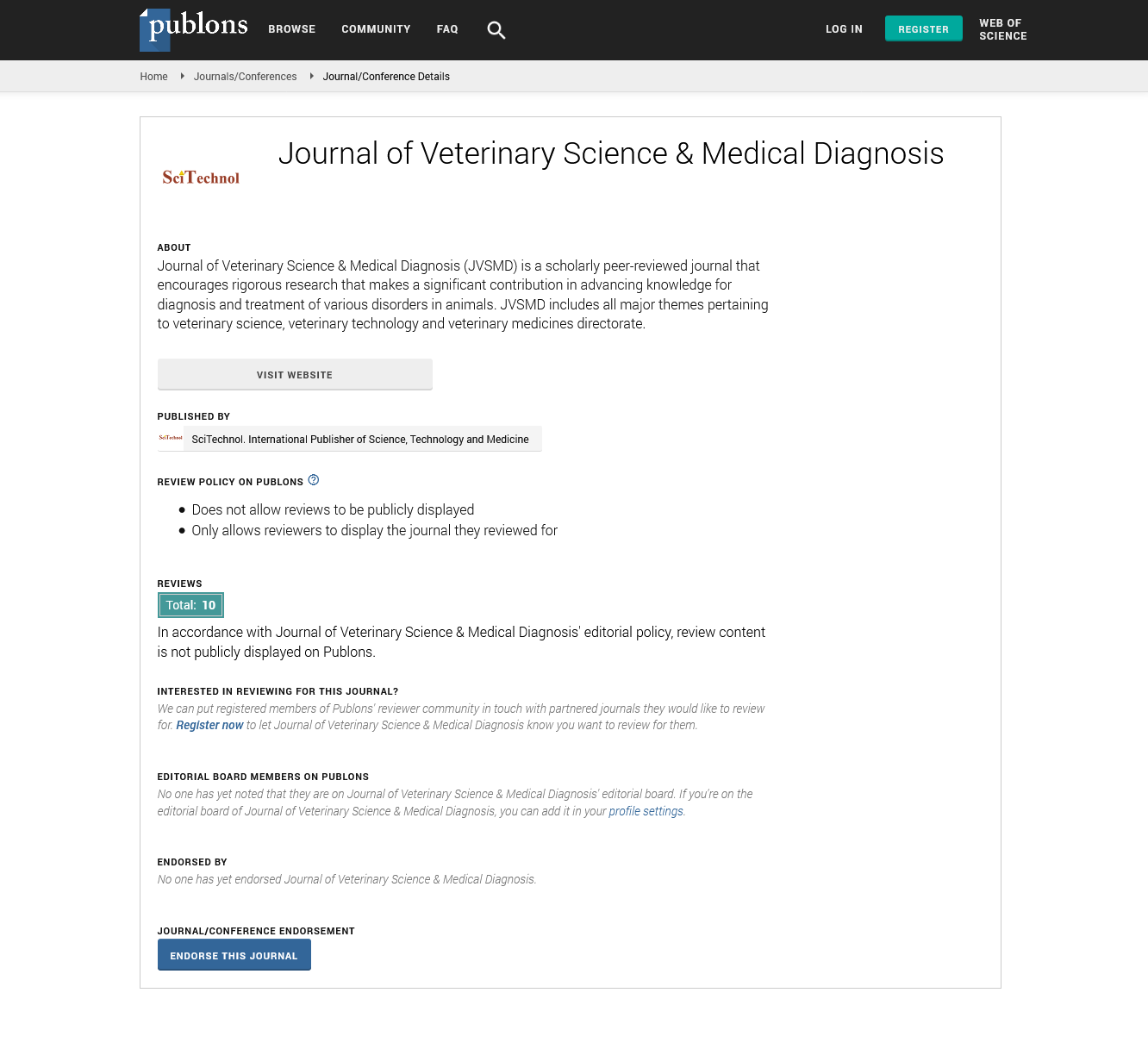Commentary, J Vet Sci Med Diagn Vol: 12 Issue: 3
Causes and Preventive Measures for Bovine Respiratory Disease in Cattle
Serkan Bakirci*
1Department of Parasitology, Aydin Adnan Menderes University, Turkey
*Corresponding Author: Serkan Bakirci
Department of Parasitology, Aydin
Adnan Menderes University, Turkey
E-mail: bakirci@ser.tr
Received date: 27 April, 2023, Manuscript No. JVSMD-23-100219;
Editor assigned date: 01 May, 2023, Pre QC No. JVSMD-23-100219(PQ);
Reviewed date: 15 May, 2023, QC No. JVSMD-23-100219;
Revised date: 22 May, 2023, Manuscript No: JVSMD-23-100219(R);
Published date: 29 May, 2023, DOI: 10.35248/2325-9590.23.12.100053.
Citation: Bakirci S (2023) Causes and Preventive Measures for Bovine Respiratory Disease in Cattle. J Vet Sci Med Diagn 12:3.
Keywords: Bovine Respiratory Disease
Description
Bovine Respiratory Disease (BRD) is a complex multifactorial disease that affects cattle, especially those raised in intensive management systems such as feedlots. The disease is caused by a combination of environmental, viral, and bacterial factors that compromise the animal's immune system and lead to respiratory infection. BRD is a significant economic burden for the livestock industry due to reduced weight gain, treatment costs, and increased mortality rates. Therefore, understanding the causes, diagnosing, and treating BRD are essential for reducing its impact on animal health and welfare and improving farm profitability.
Causes of BRD have multiple risk factors that predispose cattle to respiratory infections. The main causes of BRD are environmental factors like overcrowding, poor ventilation, high humidity, and temperature fluctuations can increase the risk of respiratory infection. Several viruses, including Bovine Viral Diarrhea Virus (BVDV), Bovine Herpesvirus-1 (BHV-1), and Bovine Respiratory Syncytial Virus (BRSV), can weaken the immune system and predispose animals to bacterial infection. Bacterial agents are the most common bacteria associated with BRD are Mannheimia haemolytica, Pasteurella multocida, and Histophilus somni. These bacteria can invade the respiratory tract and cause pneumonia, bronchitis, and pleurisy. Host factors include stress, poor nutrition, and genetic susceptibility can impair the animal's immune system and increase the risk of respiratory infection.
The diagnosis of BRD involves a combination of clinical signs, laboratory tests, and imaging techniques. The most common clinical signs of BRD are coughing, nasal discharge, fever, depression, reduced appetite, and increased respiratory rate. However, these signs can be nonspecific and can overlap with other respiratory diseases, making it challenging to distinguish BRD from other illnesses. Therefore, laboratory tests, such as bacterial culture and sensitivity, serology, and Polymerase Chain Reaction (PCR), are used to identify the causative agents of BRD. PCR is a highly sensitive and specific technique that can detect multiple pathogens simultaneously and can be used on various sample types, including nasal swabs, bronchoalveolar lavage, and lung tissue. Imaging techniques, such as thoracic radiography and ultrasonography, can also be useful for diagnosing BRD by detecting lung lesions and fluid accumulation.
The treatment of BRD involves a combination of antimicrobial therapy, supportive care, and management strategies. Antimicrobial therapy is the cornerstone of BRD treatment and should be initiated promptly to prevent disease progression and reduce the risk of secondary bacterial infections. The choice of antimicrobial agents should be based on the results of bacterial culture and sensitivity testing and should be administered for an adequate duration to ensure complete resolution of the infection. Supportive care, such as fluid therapy, anti-inflammatory drugs, and bronchodilators, can also be beneficial for reducing inflammation, improving oxygenation, and supporting the animal's immune response. Management strategies, such as improving ventilation, reducing stocking density, and minimizing environmental stressors, can also help prevent and control BRD outbreaks.
Preventing BRD is crucial for reducing the impact of the disease on animal health and welfare. Preventive measures include vaccination, biosecurity, and nutritional management. Vaccination against the major BRD pathogens, such as M. haemolytica, P. multocida, and H. somni, can reduce the incidence and severity of the disease, especially in high-risk populations. Biosecurity measures, such as quarantine, cleaning and disinfection, and limiting animal movement can prevent the introduction and spread of BRD pathogens.
Bovine Respiratory Disease (BRD) can be transmitted through various routes, including direct and indirect contact with infected animals, as well as environmental exposure to infectious agents. The primary mode of transmission is through the inhalation of aerosolized respiratory secretions containing the causative bacteria and viruses. Direct contact transmission occurs when healthy animals come into close contact with infected animals. This can occur during transportation, at auctions, or in feedlots where animals are in close proximity. Infected animals shed respiratory secretions containing the causative agents, which can be inhaled by healthy animals. Furthermore, animals may also spread the disease through contact with contaminated surfaces, equipment, and feed. Indirect contact transmission occurs through fomites, which are inanimate objects that can spread the causative agents of BRD. Fomites can include contaminated water troughs, feed bunks, equipment, and even personnel. Animals can become infected when they come into contact with fomites contaminated with infectious agents.
 Spanish
Spanish  Chinese
Chinese  Russian
Russian  German
German  French
French  Japanese
Japanese  Portuguese
Portuguese  Hindi
Hindi 
